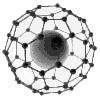
DMT-Nexus member
Posts: 1111 Joined: 18-Feb-2017 Last visit: 12-Jul-2024
|
Auxin wrote:Zinc compounds are soluble in excess ammonia, THH is not.
Zinc compounds are also soluble in ammonium chloride and ammonium sulfate, those have been used experimentally to further prevent zinc precipitation when basing with ammonia, but just using excess ammonia is reportedly sufficient. Is my thinking correct that when using HCl as acid for the reduction (instead of or on top of acetic), adding ammonium chloride is redundant, because during the subsequent basing with ammonia, the neutralization reaction produces ammonium chloride anyway? So, in a manner of speaking, using HCl kills two birds with one stone?
|
|
|
|
|

DMT-Nexus member
Posts: 557 Joined: 12-Jul-2012 Last visit: 01-Jan-2021
|
No, the salting-in effect on zinc (and cadmium) is due to the total concentration of NH4+ ions. So if you neutralized either 1M HCl or 1M acetic acid with ammonia the resulting NH4+ ions would have the same zinc dissolving power either way. I dont imagine chloride ions or acetate ions would have an effect on zinc solubility in a distinctly basic environment.
Adding ammonium chloride, sulfate, or acetate would just be a quick way to greatly increase NH4+ ion concentration without increasing the volume much (as dumping in a wild excess of ammonia would) and could get the NH4+ concentration up to zinc-dissolving levels before any alkaloid bases start precipitating and potentially trapping some precipitated zinc.
If the reduction is done with HCl then solubility of the harmalas will be an issue. Harmala hydrochlorides arent very soluble in water to start with and HCl reduces their solubility just the same as NaCl does. Strong acids can also disrupt indoles at position 3.
|
|
|

DMT-Nexus member
Posts: 1111 Joined: 18-Feb-2017 Last visit: 12-Jul-2024
|
Auxin wrote:
If the reduction is done with HCl then solubility of the harmalas will be an issue. Harmala hydrochlorides arent very soluble in water to start with and HCl reduces their solubility just the same as NaCl does.
Thanks. I actually dissolved the freebase harmaline in acetic acid, and only added the HCl later, thinking the harmaline would stay as the acetate salt, but it seems the HCl displaced the acetate ion. I have one more question about ammonium chloride. It's recommended that it be added *before* the reduction, as it supposedly increases the conversion yield from 50% to 80%. Would anyone be able to give a ballpark figure on how much ammonium chloride needs to be added, as I have no idea whatsoever? I'm doing another reduction (basically repeating the previous one, which didn't work) and I added a teaspoon of ammonium chloride to ~75ml solution of harmaline acetate. This resulted in solid particulates floating about. I'm wondering if this is undissolved ammonium chloride (Wikipedia says it's highly soluble in water, but poorly soluble in acetic acid (without saying at what concentration), so I'm not sure how these solubility figures apply to my pH ~5.2 solution) OR could the addition of too much NH4Cl have resulted in the harmaline acetate converting to the poorly soluble harmala HCl? Also, if I add the right amount of ammonium chloride before the reduction, do I still need to add more of it post-reduction to ensure the zinc and cadmium salts dissolve?
|
|
|

DMT-Nexus member
Posts: 377 Joined: 19-Aug-2017 Last visit: 15-Jan-2021
|
Any source of chloride will precipitate harmala hydrochlorides, thats what you got. Including ammonium chloride to a hot solution of harmalas is ok if its in the process of a zinc-eliminating manske but for reductions ammonium sulfate or acetate would be best. Jagube wrote:...It's recommended that it be added *before* the reduction, as it supposedly increases the conversion yield from 50% to 80%. Would anyone be able to give a ballpark figure on how much ammonium chloride needs to be added... I hadn't heard that. Conversion should reach 100% given sufficient time, acetic acid, and zinc. If there is evidence that ammonium ions speed reductions I'd like to see that. In my casual semi-quantitative experiments using ammonium sulfate to inhibit zinc precipitation it only started substantially reducing zinc precipitation once I got to a 5% ammonium sulfate solution. So I'd try to go above that. Any ammonium sulfate or acetate added at the start of the reduction should still be there through the end to inhibit zinc/cadmium precipitation when base is finally added. When the books say ammonium chloride is nearly insoluble in acetic acid they are referring to 100% glacial acetic acid.
|
|
|

DMT-Nexus member
Posts: 121 Joined: 05-May-2008 Last visit: 24-Jan-2025 Location: 2nd star to the right
|
Can anyone comment on the feasibility or dangers of reducing a crude mix of harmala's from peganum harmala using zinc and vinegar without any re-basing of the produced solution ?
ie. harmine+harmaline powder dissolved in vinegar, zinc powder added, conversion takes place, solution is decanted and reduced, ready for oral usage ?
My thought is that since zinc acetate is commonly used as a health supplement, consuming a mixture of this sort should not pose any health risk, unless of course there are other components produced during the reduction phase which are hazardous.
|
|
|

DMT-Nexus member

Posts: 14191 Joined: 19-Feb-2008 Last visit: 22-Nov-2025 Location: Jungle
|
While zinc acetate may be used as a supplement, in what dosage?
When doing this reduction, generally excess zinc is used, im not sure what would be the minimum amount needed for the conversion and how this compares to the safety of zinc in those amounts, but that'd be my main concern (apart from, of course, having zinc that possibly contains other impurities such as heavy metals or what not)
|
|
|

DMT-Nexus member
Posts: 121 Joined: 05-May-2008 Last visit: 24-Jan-2025 Location: 2nd star to the right
|
endlessness wrote:While zinc acetate may be used as a supplement, in what dosage?
When doing this reduction, generally excess zinc is used, im not sure what would be the minimum amount needed for the conversion and how this compares to the safety of zinc in those amounts, but that'd be my main concern (apart from, of course, having zinc that possibly contains other impurities such as heavy metals or what not) Most sources say 50mg three times per day. When I did this conversion in the past, most of the zinc powder didn't dissolve anyway, so I assumed that the concentration of zinc acetate in the solution was actually quite low. If one were to re-base, collect the precipitates and then redissolve in acid, without separating out the zinc carbonate beforehand would that help to eliminate possible impurities from the zinc powder? I am really just looking for a route to conversion with as few steps as possible, since I am not in need of a 100% isolated end-product, but perhaps I am just being lazy with this train of thought ;-)
|
|
|

DMT-Nexus member
Posts: 4031 Joined: 28-Jun-2012 Last visit: 05-Mar-2024
|
intosamadhi wrote:... without any re-basing of the produced solution ?... Why would you want to skip the simple step? Just poor in enough ammonia, settle for a while (like 1 hour or more, this let the crystals grow bigger), coffee filter, wash crystals with sodcarbed water, presto! (Ammonia works more charming than other bases.)
|
|
|

Boundary condition

Posts: 8617 Joined: 30-Aug-2008 Last visit: 29-Nov-2025 Location: square root of minus one
|
Just a thought about ammonia solution - it is always less dense than water. This property would lend itself to testing out ammonia-diffusion assisted freebase crystal growth in that, with sufficient care, a layer of ammonia solution could be floated atop the solution of harmala salts. Precipitation would occur only where the ammonia had reached and it would thus be possible to observe how this might affect crystal growth patterns. “There is a way of manipulating matter and energy so as to produce what modern scientists call 'a field of force'. The field acts on the observer and puts him in a privileged position vis-à-vis the universe. From this position he has access to the realities which are ordinarily hidden from us by time and space, matter and energy. This is what we call the Great Work." ― Jacques Bergier, quoting Fulcanelli
|
|
|

DMT-Nexus member
Posts: 121 Joined: 05-May-2008 Last visit: 24-Jan-2025 Location: 2nd star to the right
|
Jees wrote:intosamadhi wrote:... without any re-basing of the produced solution ?... Why would you want to skip the simple step? Just poor in enough ammonia, settle for a while (like 1 hour or more, this let the crystals grow bigger), coffee filter, wash crystals with sodcarbed water, presto! (Ammonia works more charming than other bases.) Simplicity. I don't have access to lab grade ammonia to perform this, and since I am not looking for an isolated THH extract, if there were a way to perform the conversion with an initial solution that was suitable for consumption without adding any hazardous components to it, it would make this process much more appealing. I've done the conversion before as described by Endlessness with confirmation via TLC, using 99% pure zinc powder, but I used acetone to recover the material and avoid zinc carbonate. It isn't a practical route if you are wanting to convert many grams of harmala, because the amount of acetone and the time needed to evaporate it all is a nuisance. Scanning other posts on this topic some other suggestions have been made like using magnesium or iron instead of zinc, though I expect with any powder metal there are likewise safety concerns from heavy metal toxicity? I'm wondering with this conversion using zinc, how much zinc actually converts to zinc acetate and then zinc carbonate. Has anyone done comparisons of the yields of precipitates before filtering out of zinc carbonate is done? Like i mention above, when I did this, most of the zinc seemed to remain as powder in the bottom of the jar even with heat and repeated stirring. My guess is that only a small portion actually becomes zinc acetate, and the rest remains as zinc oxide and pure unconverted/oxidized zinc powder. Which brings me back to my initial question, assuming the zinc powder used is of high purity and the solution is decanted so that there is very little risk of pure zinc ending up in the end product. Does the quantity of zinc acetate in the final solution actually pose any health risk ? (I know these are a lot of if's and without testing of the final solution to eliminate concerns about heavy metal content it can't be considered 100% safe)
|
|
|

Boundary condition

Posts: 8617 Joined: 30-Aug-2008 Last visit: 29-Nov-2025 Location: square root of minus one
|
It would be a matter of weighing the (dry) zinc powder before and after the reaction. Then you could put a figure to it, and use that figure to relate to known and searchable values for zinc toxicity, perhaps assuming that the remaining 1% of the 'high purity' zinc is copper, or cadmium, or lead, or mercury. Producing your own ammonia is not difficult if you have access to an ammonium salt and a reasonably strong base. Doing so safely requires a modicum of technical knowledge, of course. “There is a way of manipulating matter and energy so as to produce what modern scientists call 'a field of force'. The field acts on the observer and puts him in a privileged position vis-à-vis the universe. From this position he has access to the realities which are ordinarily hidden from us by time and space, matter and energy. This is what we call the Great Work." ― Jacques Bergier, quoting Fulcanelli
|
|
|

DMT-Nexus member
Posts: 1104 Joined: 11-Feb-2017 Last visit: 18-Jan-2021
|
I use a heavy metal test strips to check the THH solution and I found there is less than 100 ppb of heavy metal cations (Zn(II)) in a concentrated solution of THH I made from the final product. The tests strips check for many heavy metals, not only zinc. Metals like tin, cobalt, copper, lead, mercury etc. If there is less than 100 ppb in the entire solution, then the THH precipitate is certainly safe. What I do is to filter the reaction mixture (containing THH and metal acetates) first through a paper filter, then I precipitate THH freebase with 5% ammonia (slow addition, strong stirring), filter, wash, redissolve crude THH in warm vinegar, filter through a bed of diatomaceous earth and finally re-precipitate with 5% ammonia, filter, wash, dry. Note that acetic acid is too weak to dissolve most metals unless they are oxidized. Finally, I neutralize the spent reaction mixture with just enough NaOH. This should precipitate the zinc as zinc hydroxide without redissolving it as zincate. If you are still concerned about pouring traces of heavy metals down the drain, they can be removed from waste water by the addition of sodium sulfide soln. It causes precipitation of the said metals as sulfides, which are practically insoluble in water. I use this method to process aqueous copper and mercury waste water in my hobby lab. Even if some metals slip through to the product, this is not a big deal. Our bodies detoxify from heavy metals (otherwise people living in cities would be aready dead  ), though slowly, not to mention these are already normally present in food (e.g. fish).
|
|
|

DMT-Nexus member
Posts: 1111 Joined: 18-Feb-2017 Last visit: 12-Jul-2024
|
How much of the zinc metal will react and dissolve, depends on how long you let the reaction run for (assuming enough acidity), not the amount of harmaline in your solution. Even without any harmaline, all the zinc will eventually dissolve, as long as there is enough H+ ions to match the number of zinc molecules. For some stoichiometric calculations, see https://www.youtube.com/...=Hif_SnVgkJA&t=523s for vinegar and https://www.anoniem.org/...=Hif_SnVgkJA&t=582s for zinc. You need at least one zinc molecule for one harmaline molecule, so you should expect at least that amount of zinc to have dissolved upon the completion of a reduction. If less has dissolved, the reduction is incomplete. In practice I imagine it must be more, because the reaction of zinc with acid releases hydrogen gas, some of which escapes before it gets a chance to reduce harmaline.
|
|
|

DMT-Nexus member
Posts: 1104 Joined: 11-Feb-2017 Last visit: 18-Jan-2021
|
Sure, stoichiometric excess is almost always used in practice so that the reaction is driven to completion in reasonable time. The VDS paper uses 2 grams (30.59 mmol) of zinc per 3 grams (14 mmol) of harmaline. That is almost 220% the molar amount of zinc vs harmaline, i.e. two molecules of zinc per molecule of harmaline  Of course, the reaction time also depends on temperature and concentration.
|
|
|
DMT-Nexus member
Posts: 24 Joined: 20-Mar-2019 Last visit: 23-Nov-2022
|
endlessness wrote:So, small update. Harmine does NOT get reduced to harmaline and THH with zinc, as analysis has show today. Harmine stays intact. So trying to reduce a mixture of harmine/harmaline will leave harmine intact and reduce the harmaline to THH. If you want THH, better do a couple of selective pH precipitations to separate harmine and harmaline, and then use only the harmaline (or 'mostly' harmaline at least). Kind of late to the game, just reading through this so sorry if a little out of place. I think you could reduce the Harmine with a stronger reducing agent (maybe platinum and hydrogen gas) but it might reduce any available nucleophilic pi bond on the molecule as well. Not aware of any selective reducing agents that would fit this application. A protecting grop of some kind might work but that's beyond my knowledge. Cool stuff guys! exciting to see this kind of stuff in the hobby science circle. Allot of great things happening on this forum!
|
|
|

DMT-Nexus member
Posts: 307 Joined: 31-Dec-2016 Last visit: 10-Mar-2024 Location: Nkandla
|
A question regarding the THH reduction process as demonstrated in the above-linked video by Gordotek:
The first step involves dissolving a freebase harmala mix in acid.
If I have a quantity of (unseparated) harmine/harmaline mix from a rue extraction in the HCl form (directly from Manske crystalisation) can this be used without the need to first convert the mix to the freebase form?
|
|
|

DMT-Nexus member
Posts: 4031 Joined: 28-Jun-2012 Last visit: 05-Mar-2024
|
merkin wrote:A question regarding the THH reduction process as demonstrated in the above-linked video by Gordotek:
The first step involves dissolving a freebase harmala mix in acid.
If I have a quantity of (unseparated) harmine/harmaline mix from a rue extraction in the HCl form (directly from Manske crystalisation) can this be used without the need to first convert the mix to the freebase form? Hi, Yes you could dissolve the mansked crystals into water and add vinegar, or use no water and put them straight into kitchen vinegar. Add zinc, go from there.
|